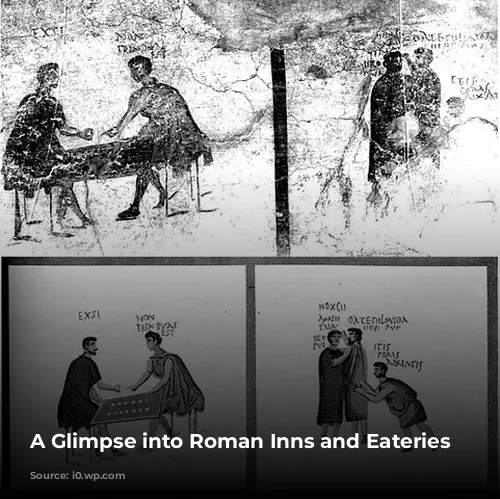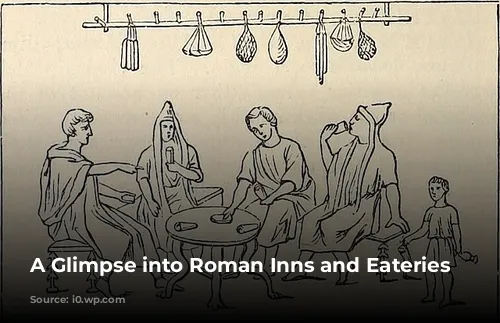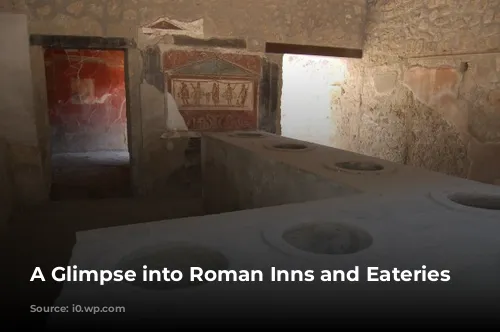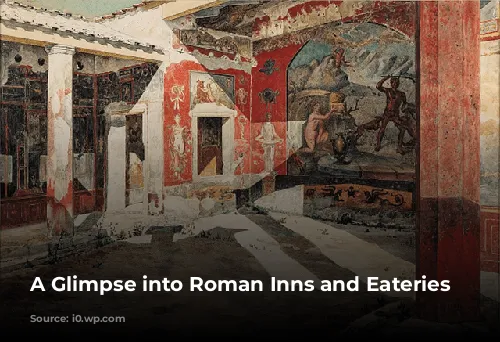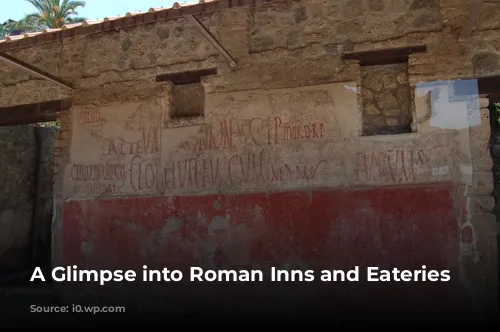Imagine stepping back in time to ancient Rome. You’re not just strolling through bustling marketplaces and grand forums, you’re also experiencing the vibrant social life that unfolded in its many eateries. Roman cities weren’t just about grand structures; they buzzed with the energy of everyday life, and food was a central part of it.
The Many Faces of Roman Eateries
The Romans had an array of establishments catering to diverse needs, from quick bites to overnight stays. Let’s explore some of these fascinating places.
Cauponae, tabernae, popinae, and thermopolia were all common eateries, each with its unique character. These establishments dotted the city’s busy areas, close to the forum, bathhouses, and residential streets. They offered a range of options: snacks to go, sit-down meals, drinks, and even a place to rest for the night.
Cauponae and tabernae served as the Roman equivalents of taverns. They offered a similar mix of food and drink, although cauponae could also provide basic accommodation in rooms above the bar. These establishments were often bustling with activity, and many, like Asellina’s Tavern in Pompeii, were one-room shops serving simple, affordable food. They were also popular drinking spots, with patrons often enjoying wine late into the night while indulging in games of chance.
A Look Inside a Typical Tavern
Stepping into a caupona or taberna, you would find a large, L-shaped marble counter serving as the heart of the establishment. This counter, typically between six and eight feet long, was designed to accommodate a variety of activities. Large pottery dolia filled with snacks like dried fruit and pulses lined the counter, while amphorae filled with wine were kept behind it. The staff cooked food on simple braziers behind the counter, adding to the vibrant atmosphere. Patrons could choose to stand at the counter or grab a table in the open-plan communal area, or even enjoy a more private experience in a secluded booth with masonry seats.
A Mixed Reputation
While these establishments played a vital role in Roman life, they weren’t always viewed favorably. Ancient writers like Ammianus Marcellus saw them as places frequented by the lower classes, and the poet Horace even described them as “greasy.” This reputation was further tainted by the fact that some waiting staff also offered sexual services.
From Raucous Nights to Formal Dining
These taverns, like bars today, could be rowdy and disreputable. One Pompeii tavern even had a cartoon depicting a heated argument over a dice game, culminating in a brawl that led to the patrons’ eviction.
Despite this, not all taverns were known for their rowdy atmosphere. Some aimed to attract a more refined clientele, offering private dining rooms with formal couches and a circular table. These establishments provided a more secluded and elegant setting for those seeking a break from the city’s hustle or a place to conduct business lunches.
The World of Thermopolia
Thermopolia were smaller booths with a counter facing the street, serving takeout snacks to passersby. A good example of this type of eatery is the bar of Vetutius Placidus in Pompeii. Thermopolia sometimes operated as an offshoot of a larger caupona or taberna, offering a wider range of services. Asellina’s Tavern, for example, functioned as both a taberna/caupona and a thermopolium, with one end of its counter serving takeout snacks directly onto the street.
Popinae: The Lowest of the Low
Popinae were another type of Roman eatery, similar in function to cauponae, tabernae, and thermopolia, but considered to be the lowest-grade cookshops. They were typically frequented by the poorest citizens and slaves, offering quick, cheap, and unsophisticated meals.
These establishments usually had an L-shaped counter where customers were served, but their facilities were more basic. Patrons often stood or perched on stools while enjoying their snacks and cheap wine. Juvenal, a Roman satirist, described the typical clientele of a popina in Ostia as including thieves, sailors, fugitive slaves, coffin makers, assassins, and even a priest of Cybele.
Roman Hotels: From Private Homes to Seedier Establishments
While many Romans frequented eateries for their meals, they also needed places to stay when travelling. Hospitia, the Roman equivalent of hotels, were initially rented rooms in private homes. However, as time went on, they became more commercialized, with many converted from former private homes to offer guests food, drink, and lodging.
These hotels varied in their offerings. Some had private dining rooms, garden triclinia, and formal atriums, catering to a more affluent clientele. Others were more basic, resembling cauponae with a central bar area for eating and rooms for sleeping elsewhere. These establishments were often considered seedy, as travelers frequently rented little more than a bug-infested mattress and blanket on the floor of a shared room.
The House of Sallust: A More Refined Option
One notable example of a more luxurious hospitium was the House of Sallust in Pompeii. Originally a private residence, it was converted into a hotel during the Augustan period, boasting a more comfortable and refined atmosphere.
Stabula: Motels with a Stable
Stabula were a specific type of Roman motel found at the entrances of towns and cities. These establishments differed from hospitia in that they provided facilities for stabling animals alongside rooms for guests. The presence of a ramped entrance sloping onto the street, allowing access for carts and pack animals, was a telltale sign of a stabulum.
Animals were accommodated in stables at the back of the complex, typically in a courtyard area with kitchens and latrines. Guests were usually housed at the front of the complex, although they could also be accommodated in rooms above the stables.
Mansiones: Rest Stops Along the Roman Road Network
Mansiones were the Roman equivalent of motorway service stations, appearing at regular intervals along the Roman road network. Their name derives from the Latin word “manere”, signifying their purpose as places for travellers to rest for the night.
Mansiones were officially run by the state, providing facilities for those on imperial business to change horses and rest. However, they also offered food and accommodation to ordinary travelers. The Antonine Itinerary, a third-century imperial travelogue, mentions a mansio in the Roman town of Venonae in Leicestershire, Britain.
These diverse and fascinating eateries and inns provide a glimpse into the everyday life of ancient Rome. From the quick bites offered by thermopolia to the luxurious accommodations of the House of Sallust, these establishments played a vital role in the city’s bustling social fabric, showcasing the Romans’ ingenuity and adaptability.
